The Economics and Statistics Division maintains archives of previous publications for accountability purposes, but makes no updates to keep these documents current with the latest data revisions from Statistics Canada. As a result, information in older documents may not be accurate. Please exercise caution when referring to older documents. For the latest information and historical data, please contact the individual listed to the right.
<--- Return to Archive
For additional information relating to this article, please contact:
August 29, 2019CANADA'S BALANCE OF INTERNATIONAL PAYMENTS 2019Q2 SECOND QUARTER
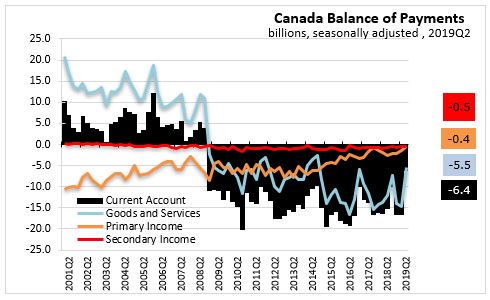
In Canada 2019 Q2, the seasonally adjusted current account deficit decreased $10.2 billion to $6.4 billion over 2019 Q1.

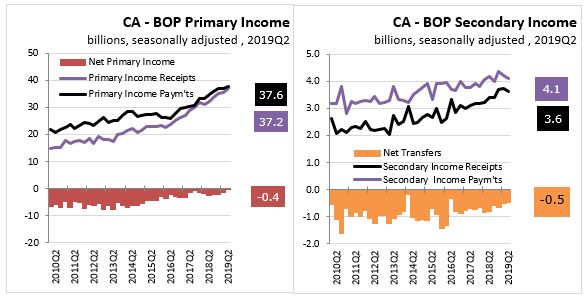
In 2019 Q2,
- exports (receipts) goods and services increased $8,041 million to $185.8 billion, while imports (payments) goods and services decreased $1,254 million to $191.3 billion over 2019 Q1. The resulting international goods and services trade deficit decreased $9.3 billion to $5.5 billion over 2019 Q1.
- primary income receipts increased $1,523 million to $37.2 billion over 2019 Q1. while primary income payments increased $591 million to $37.6 billion over 2019 Q1. The resulting international primary income trade deficit decreased $933 million to $0.4 billion over 2019 Q1.
- secondary income receipts decreased $93 million to $3.6 billion over 2019 Q1. while secondary income payments decreased $110 million to $4.1 billion over 2019 Q1. The resulting international secondary income trade deficit decreased $17 million to $0.5 billion over 2019 Q1.
- with the international goods and services trade deficit decreasing ($9.3 billion); the international primary income trade deficit decreasing ($933 million); the international secondary income trade deficit decreasing ($17 million); the seasonally adjusted current account deficit decreased $10.2 billion to $6.4 billion.
SECOND QUARTER BALANCE OF PAYMENTS WITH THE UNITED STATES
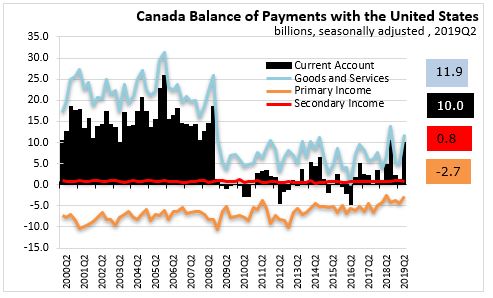
In 2019 Q2, the seasonally adjusted Canada-United States current account surplus increased $8.7 billion to $10.0 billion over 2019 Q1.
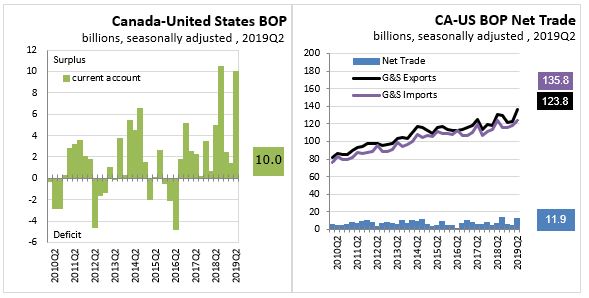
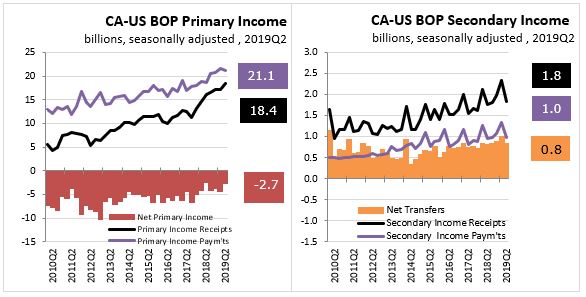
In 2019 Q2,
- exports (receipts) goods and services increased $13.3 billion to $135.8 billion, while imports (payments) goods and services increased $6.2 billion to $123.8 billion. The resulting international goods and services trade surplus increased $7.2 billion to $11.9 billion over 2019 Q1.
- primary income receipts increased $1.3 billion to $18.4 billion, while primary income payments decreased $425 million to $21.1 billion. The resulting international primary income trade deficit decreased $1.7 billion to $2.7 billion over 2019 Q1.
- secondary income receipts decreased $518 million to $1.8 billion, while secondary income payments decreased $363 million to $1.0 billion. The resulting international secondary income trade surplus decreased $154 million to $0.8 billion over 2019 Q1
- with the international goods and services trade surplus increasing ($7.2 billion); the international primary income trade deficit increasing ($1.7 billion); the international secondary income trade surplus decreasing ($154 million); the seasonally adjusted United States current account surplus increased $8.7 billion to $10.0 billion.
SECOND QUARTER BALANCE OF PAYMENTS WITH NON-US COUNTRIES
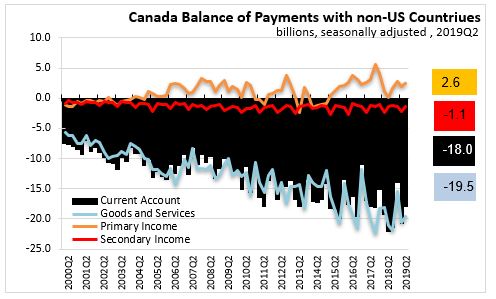
In 2019 Q2, the seasonally adjusted Canada-nonUS Countries current account deficit decreased $2.9 billion to $18.0 billion over 2019 Q1.
FIRST QUARTER INTERNATIONAL COMPETITIVENESS
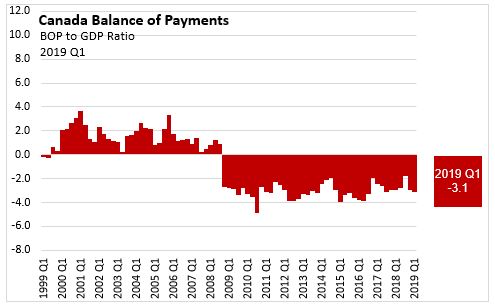
The ratio of the current account balance to the Gross Domestic Product (or % of GDP) provides an indication of the country's level of international competitiveness.
It is calculated by dividing the net values of exports less imports, primary Income (interest and dividends) and secondary income (transfers) over a period by the gross domestic product for the same period. Although called a ratio, it is usually expressed as a percentage.
In the period 1999 Q3 to 2008 Q3, Canada’s international competitiveness was positive. ranging from 0.2% to 3.6%. With the recession in 2008, Canada's international competitiveness ratio turned negative. In 2008 Q4 the ratio declined 3.6 points over 2008 Q3.
In the period 2008 Q4 to 2019 Q1, Canada's international competitiveness has remained negative.
In Canada 2019 Q1, the seasonally adjusted current account as a % of GDP or international competitiveness measure, widened 0.1 percentage points to a 3.1% deficit over the previous quarter, and the deficit widened 0.1 percentage points over the same quarter last year.
REFERENCES
Statistics Canada
Table: 36-10-0018-01 Quarterly
Table: 36-10-0016-01 Quarterly by country (i.e US, ALL)
OECD
Table: Balance of Payments BPM6: Current account balance as a % of GDP
<--- Return to Archive